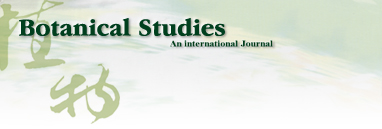 |
|
|
| TITLE | Tissue-specific and developmental regulation of camptothecin and 10-hydroxycamptothecin levels in Camptotheca acuminata |
| AUTHOR | Xiu-Feng YAN College of Life Sciences, Northeast Forestry University, Harbin 150040, P. R. China Yang WANG College of Life Sciences, Northeast Forestry University, Harbin 150040, P. R. China Yu-Hong ZHANG Open Research Laboratory of Forest Plant Ecology, Northeast Forestry University, Harbin 150040, P. R. China Tao YU College of Life Sciences, Northeast Forestry University, Harbin 150040, P. R. China Mei-Fang MA College of Life Sciences, Northeast Forestry University, Harbin 150040, P. R. China Shi-Jie JU College of Life Sciences, Northeast Forestry University, Harbin 150040, P. R. China Sixue CHEN Donald Danforth Plant Science Center, St. Louis, MO 63146, U.S.A. |
| FULL TEXT | [in HTML format] [in PDF format] |
| ABSTRACT | Camptothecin (CPT) and its analogue 10-hydroxycamptothecin (HCPT) are two naturally occurring monoterpene indole alkaloids in Camptotheca acuminata. They both show potential efficacy as anti-cancer compounds as well as act as defensive chemicals in plants. Here we report the regulation of CPT and HCPT contents in C. acuminata during seed imbibition and seedling development. The levels of CPT in endosperm was 2 to 3 fold higher than in other tissues, and clearly decreased during the imbibition period. In other tissues, CPT contents exhibited slight fluctuations. In comparison, HCPT contents in all the tissues were much lower. HCPT was less abundant in cotyledon and embryonal axis than in endosperm and seed coat. During seedling development, CPT and HCPT contents in cotyledons reached maximum at 9-15 days stage. In embryonal axis, CPT contents decreased logarithmically, while HCPT content followed the same pattern as in cotyledons. CPT and HCPT levels in radicles were very low, with CPT levels remaining constant and HCPT levels decreasing during development. In leaves, the contents of CPT showed linear reduction during seedling growth. These results demonstrate that the levels of CPT and HCPT are tissue-specifically and developmentally regulated. The physiological implications and significance of the regulation are discussed. |
| KEYWORD | Camptotheca acuminata; Camptothecin; 10-hydroxycamptothecin levels; Regulation; |
| ARTICLE INFO | Botanical Bulletin of Academia Sinica, Volume 46 Number 4 October 2005, page 325-331, 7 pages |
| PUBLISHER | Institute of Plant and Microbial Biology, Academia Sinica, Taipei, Taiwan, Republic of China |
